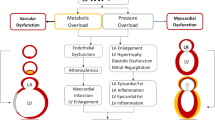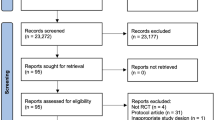Abstract
Aerobic exercise training in the heart failure (HF) population is supported by an extensive body of literature. The clinically accepted model for exercise prescription is currently moderate-intensity-aerobic continuous training (MI-ACT). Documented benefits from the literature include improvements in various aspects of physiologic function, aerobic exercise capacity and quality of life while the impact on morbidity and mortality is promising but requires further investigation. Recently, however, a body of evidence has begun to emerge demonstrating high-intensity-aerobic interval training (HI-AIT) can be performed safely with impressive improvements in physiology, functional capacity and quality of life. These initial findings have led some to question the long-standing clinical approach to aerobic exercise training in patients with HF (i.e., MI-ACT), implying it should perhaps be replaced with a HI-AIT model. This is a potentially controversial paradigm shift given the potential increase in adverse event risk associated with exercising at higher intensities, particularly in the HF population where the likelihood of an untoward episode is already at a heightened state relative to the apparently healthy population. The present review therefore addresses key issues related to HI-AIT in the HF population and makes recommendations for future research and current clinical practice.

Similar content being viewed by others

References
Lee AP, Ice R, Blessey R, Sanmarco ME (1979) Long-term effects of physical training on coronary patients with impaired ventricular function. Circulation 60:1519–1526
O’Connor CM, Whellan DJ, Lee KL, Keteyian SJ, Cooper LS, Ellis SJ, Leifer ES, Kraus WE, Kitzman DW, Blumenthal JA, Rendall DS, Miller NH, Fleg JL, Schulman KA, McKelvie RS, Zannad F, Piña IL (2009) Efficacy and safety of exercise training in patients with chronic heart failure. JAMA 301:1439–1450
Downing J, Balady GJ (2011) The role of exercise training in heart failure. J Am Coll Cardiol 58:561–569
Keteyian SJ (2010) Exercise in the management of patients with chronic heart failure. Curr Heart Fail Rep 7:35–41
Keteyian SJ, Fleg JL, Brawner CA, Pina IL (2010) Role and benefits of exercise in the management of patients with heart failure. Heart Fail Rev 15:523–530
Davies EJ, Moxham T, Rees K, Singh S, Coats AJS, Ebrahim S, Lough F, Taylor RS (2010) Exercise training for systolic heart failure: cochrane systematic review and meta-analysis. Eur J Heart Fail 12:706–715
Exercise training meta-analysis of trials in patients with chronic heart failure (ExTraMATCH) (2004) BMJ 328:189–190
Balady GJ, Williams MA, Ades PA, Bittner V, Comoss P, Foody JM, Franklin B, Sanderson B, Southard D (2007) Core components of cardiac rehabilitation/secondary prevention programs: 2007 Update: a scientific statement from the American heart association exercise, cardiac rehabilitation, and prevention Committee, the Council on Clinical cardiology; the councils on cardiovascular nursing, epidemiology and prevention, and nutrition, physical activity, and metabolism; and the American association of Cardiovascular and pulmonary rehabilitation. Circulation 115:2675–2682
Jessup M, Abraham WT, Casey DE, Feldman AM, Francis GS, Ganiats TG, Konstam MA, Mancini DM, Rahko PS, Silver MA, Stevenson LW, Yancy CW (2009) Focused Update: ACCF/AHA guidelines for the diagnosis and management of heart failure in adults: a report of the American College of Cardiology foundation/American Heart Association task force on practice guidelines: developed in collaboration with the International Society for Heart and Lung Transplantation. Circulation 119:1977–2016
Wisloff U, Stoylen A, Loennechen JP, Bruvold M, Rognmo O, Haram PM, Tjonna AE, Helgerud J, Slordahl SA, Lee SJ, Videm V, Bye A, Smith GL, Najjar SM, Ellingsen O, Skjaerpe T (2007) Superior cardiovascular effect of aerobic interval training versus moderate continuous training in heart failure patients: a randomized study. Circulation 115:3086–3094
Thompson PD, Franklin BA, Balady GJ, Blair SN, Corrado D, Estes NA III, Fulton JE, Gordon NF, Haskell WL, Link MS, Maron BJ, Mittleman MA, Pelliccia A, Wenger NK, Willich SN, Costa F (2007) Exercise and acute cardiovascular events placing the risks into perspective: a scientific statement from the American Heart Association Council on nutrition, physical activity, and metabolism and the council on clinical cardiology. Circulation 115:2358–2368
Kemi OJ, Wisloff U (2010) High-intensity aerobic exercise training improves the heart in health and disease. J Cardiopulm Rehabil Prev 30:2–11
Boutcher SH (2011) High-intensity intermittent exercise and fat loss. J Obes 2011:868305
Trapp EG, Chisholm DJ, Freund J, Boutcher SH (2008) The effects of high-intensity intermittent exercise training on fat loss and fasting insulin levels of young women. Int J Obes (Lond) 32:684–691
Myers J, Ashley E (1997) Dangerous curves. A perspective on exercise, lactate, and the anaerobic threshold. Chest 111:787–795
Sullivan MJ, Higginbotham MB, Cobb FR (1989) Exercise training in patients with chronic heart failure delays ventilatory anaerobic threshold and improves submaximal exercise performance. Circulation 79:324–329
Smart NA, Dieberg G, Giallauria F (2011). Intermittent versus continuous exercise training in chronic heart failure: a meta-analysis. Int J Cardiol (in press)
Meyer P, Normandin E, Gayda M, Billon G, Guiraud T, Bosquet L, Fortier A, Juneau M, White M, Nigam A (2012) High-intensity interval exercise in chronic heart failure: protocol optimization. J Card Fail 18:126–133
Stoylen A, Conraads V, Halle M, Linke A, Prescott E, Ellingsen O (2011) Controlled study of myocardial recovery after interval training in heart failure: SMARTEX-HF—rationale and design. Eur J Cardiovasc Prev Rehabil (in press)
Chidnok W, Dimenna FJ, Bailey SJ, Vanhatalo A, Morton RH, Wilkerson DP, Jones AM (2012) Exercise tolerance in intermittent cycling: application of the critical power concept. Med Sci Sports Exerc 44:966–976
Jones AM, Vanhatalo A, Burnley M, Morton RH, Poole DC (2010) Critical power: implications for determination of V O2max and exercise tolerance. Med Sci Sports Exerc 42:1876–1890
Midgley AW, Mc Naughton LR (2006) Time at or near VO2max during continuous and intermittent running. A review with special reference to considerations for the optimisation of training protocols to elicit the longest time at or near VO2max. J Sports Med Phys Fitness 46:1–14
Dimopoulos S, Anastasiou-Nana M, Sakellariou D, Drakos S, Kapsimalakou S, Maroulidis G, Roditis P, Papazachou O, Vogiatzis I, Roussos C, Nanas S (2006) Effects of exercise rehabilitation program on heart rate recovery in patients with chronic heart failure. Eur J Cardiovasc Prev Rehabil 13:67–73
Fu TC, Wang CH, Lin PS, Hsu CC, Cherng WJl (2011). Aerobic interval training improves oxygen uptake efficiency by enhancing cerebral and muscular hemodynamics in patients with heart failure. Int J Cardiol (in press)
Meyer K, Samek L, Schwaibold M, Westbrook S, Hajric R, Beneke R, Lehmann M, Roskamm H (1997) Interval training in patients with severe chronic heart failure: analysis and recommendations for exercise procedures. Med Sci Sports Exerc 29:306–312
Tasoulis A, Papazachou O, Dimopoulos S, Gerovasili V, Karatzanos E, Kyprianou T, Drakos S, Anastasiou-Nana M, Roussos C, Nanas S (2010) Effects of interval exercise training on respiratory drive in patients with chronic heart failure. Respir Med 104:1557–1565
Anagnostakou V, Chatzimichail K, Dimopoulos S, Karatzanos E, Papazachou O, Tasoulis A, Anastasiou-Nana M, Roussos C, Nanas S (2011) Effects of interval cycle training with or without strength training on vascular reactivity in heart failure patients. J Card Fail 17:585–591
Freyssin C, Verkindt C, Prieur F, Benaich P, Maunier S, Blanc P (2012). Cardiac rehabilitation in chronic heart failure: effect of an 8-week, high-intensity interval training versus continuous training. Archives of Physical Medicine and Rehabilitation (in press)
Pina IL, Apstein CS, Balady GJ, Belardinelli R, Chaitman BR, Duscha BD, Fletcher BJ, Fleg JL, Myers JN, Sullivan MJ (2003) Exercise and heart failure: a statement from the american heart association committee on exercise, rehabilitation, and prevention. Circulation 107:1210–1225
Tomczak CR, Thompson RB, Paterson I, Schulte F, Cheng-Baron J, Haennel RG, Haykowsky MJ (2011) Effect of acute high-intensity interval exercise on postexercise biventricular function in mild heart failure. J Appl Physiol 110:398–406
Sengupta PP, Tajik AJ, Chandrasekaran K, Khandheria BK (2008) Twist mechanics of the left ventricle: principles and application. JACC Cardiovasc Imaging 1:366–376
Keren H, Burkhoff D, Squara P (2007) Evaluation of a noninvasive continuous cardiac output monitoring system based on thoracic bioreactance. Am J Physiol Heart Circul Physiol 293:H583–H589
Kemi OJ, Loennechen JP, Wisloff U, Ellingsen O (2002) Intensity-controlled treadmill running in mice: cardiac and skeletal muscle hypertrophy. J Appl Physiol 93:1301–1309
Kemi OJ, Haram PM, Loennechen JP, Osnes JB, Skomedal T, Wisloff U, Ellingsen O (2005) Moderate vs. high exercise intensity: differential effects on aerobic fitness, cardiomyocyte contractility, and endothelial function. Cardiovasc Res 67:161–172
Wisloff U, Helgerud J, Kemi OJ, Ellingsen O (2001) Intensity-controlled treadmill running in rats: VO(2 max) and cardiac hypertrophy. Am J Physiol Heart Circ Physiol 280:H1301–H1310
Kemi OJ, Haram PM, Wisloff U, Ellingsen O (2004) Aerobic fitness is associated with cardiomyocyte contractile capacity and endothelial function in exercise training and detraining. Circulation 109:2897–2904
Braith R, Beck D (2008) Resistance exercise: training adaptations and developing a safe exercise prescription. Heart Fail Rev 13:69–79
Tabet JY, Meurin P, Beauvais F, Weber H, Renaud N, Thabut G, Cohen-Solal A, Logeart D, Driss AB (2008) Absence of exercise capacity improvement after exercise training program/clinical perspective. Circ Heart Fail 1:220–226
Keteyian SJ (2011) Exercise training in congestive heart failure: risks and benefits. Prog Cardiovasc Dis 53:419–428
Conflict of interest
None.
Author information
Authors and Affiliations
Corresponding author
Rights and permissions
About this article
Cite this article
Arena, R., Myers, J., Forman, D.E. et al. Should high-intensity-aerobic interval training become the clinical standard in heart failure?. Heart Fail Rev 18, 95–105 (2013). https://doi.org/10.1007/s10741-012-9333-z
Published:
Issue Date:
DOI: https://doi.org/10.1007/s10741-012-9333-z



